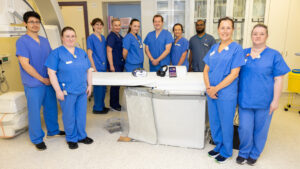Michael Brassil

Consultant Interventional Radiologist
Michael Brassil
In his role as an Interventional radiologist, Michael diagnoses and treats a wide variety of diseases. He cares for patients who have a range of medical conditions by harnessing the power of advanced imaging (Ultrasound, X-ray, CT) to perform minimally invasive surgery with unprecedented precision.
Some examples of Interventional Radiology (IR) procedures include delivering targeted cancer chemotherapy and facilitating kidney dialysis by placing tubes in large chest veins or taking samples of tissue (biopsies) from the liver, kidney, chest, and bones to find out what might be causing diseases.
Cutting edge Innovation
Michael and the interventional radiology team in TUH are the only IR Department in Ireland using Virtual Reality (VR) Headsets to help prevent and alleviate pain and anxiety for their patients during the procedures that they carry out.
Michael says, “Some patients who had always received intravenous sedation for certain reoccurring procedures now don’t need it because of the VR Headsets. For other patients, we can use less anaesthetic to carry out their image-guided surgery. The VR headsets help the patient to relax, improving their overall comfort level and leading to a better experience.”
Preliminary medical studies have found VR effective as an aid to anaesthesia to reduce pain and anxiety for patients during upper gastrointestinal endoscopies, dental procedures and joint arthroplasties (a surgery to replace some or all of the joint).

Motivation
The Consultant Interventional Radiologist says, “There are numerous benefits of avoiding IV sedation for patients. Some patients will no longer need to fast before their procedure, they will recover quicker and can be discharged sooner. Some of the minimally invasive procedures we carry out to treat patients can be performed using local anaesthesia whilst others have traditionally required intravenous sedation. Often intravenous sedation is required primarily to address patient anxiety rather than physical pain. I observed from working in other healthcare systems, that there was a wide variation in practice when it comes to patient comfort. I wanted to explore medical hypnosis/virtual sedation as an alternative to intravenous sedation for suitable patients.”
Biggest learning
Michael says, “There are talented and helpful people working in the Hospital, particularly in the Innovation office and in TUH. This means that if you have a good idea to help patients, there is help and advice on hand to make it a reality.
I’ve learned how important it is to seek advice from the right people. Engaging with suppliers, getting quotations, and selecting the right product or service can be daunting for a clinician, but I’ve found support is always available.”
“Initiating change in an established healthcare system requires buy-in from all stakeholders, our dedicated and motivated nurses and radiographers have been instrumental in the success of our virtual sedation programme, they are often the ones to explain the process to the patients and guide them through their journey”.
What’s next?
The Consultant Interventional Radiologist says, “I’ve always been interested in patient education. I feel that sometimes patients can have a limited understanding of what we offer in Interventional Radiology. Although there are some excellent online resources and written information leaflets, not everyone can engage with that format of education. I would like to develop a resource for patients where they can learn a little or a lot about the procedures we offer. First-hand patient accounts of their experiences are often more reassuring and interesting for prospective patients to hear than medical jargon. I hope that we can develop a virtual platform locally that would be specific for who we are and what we do.”